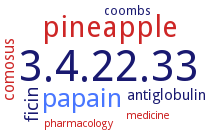3.4.22.33: Fruit bromelain
This is an abbreviated version!
For detailed information about Fruit bromelain, go to the full flat file.

Reaction
Hydrolysis of proteins with broad specificity for peptide bonds. Bz-Phe-Val-Arg-/-NHMec is a good synthetic substrate, but there is no action on Z-Arg-Arg-NHMec (c.f. stem bromelain) =
Synonyms
ACMD2_17643, Ananase, Bromelain, bromelain A, bromelain B, Bromelain, juice, Bromelase, Bromelin, EC 3.4.22.4, EC 3.4.22.5, EC 3.4.4.24, Extranase, fastuosain, FBM, Fruit bromelain, Fruit bromelain FA2, Juice bromelain, More, Pinase, Traumanase
ECTree
Advanced search results
General Stability
General Stability on EC 3.4.22.33 - Fruit bromelain
Please wait a moment until all data is loaded. This message will disappear when all data is loaded.
analysis of the stability of fruit bromelain in fruit pulp within a high-pressure domain of 0.1-600 MPa/30-70°C/1 s-30 min. The pulse effect is quantified as a function of pressure, temperature, pressure build-up and decompression times. A maximum of 60% reduction in FBM activity is obtained after a single pulse of 600 MPa/70°C. Upon applying nth order model, the obtained reaction order (n) for thermal (0.1 MPa/30-70°C) and high-pressure (100-600 MPa/30-70°C) inactivation is 1.1 and 1.2, respectively, inactivation rate constant, isothermal inactivation at atmospheric pressure, detailed overview. The activation energy is nonlinearly dependent on pressure, whereas the activation volume is linearly related to temperature. The empirical model appears to be more realistic than those from the log-linear kinetics. At 600 MPa/70°C, the first-order kinetics predict that 90% of initial FBM activity will be reduced after 46 min of pressure hold period, whereas, the empirical model predicts a dwell time of only 26 min for the same. Modelling
incubation with trypsin (1 mg/ml, 1 h, 37°C) results in 12% loss of activity (with benzyloxycarbonyl-Arg-Arg-p-nitroanilide as substrate) at bromelain concentration of 10 mg/ml , but has no effect on activity at bromelain concentrations of 100 mg/ml
-
proteolytic activity of solutions containing either 10 mg/ml or 100 mg/ml bromelain in water or 100 mg/ml NaHCO3 is not changed against benzyloxycarbonyl-Arg-Arg-p-nitroanilide and benzoyl-Phe-Val-Arg-p-nitroanilide substrate by four freeze/thaw cycles
-


 results (
results ( results (
results ( top
top





